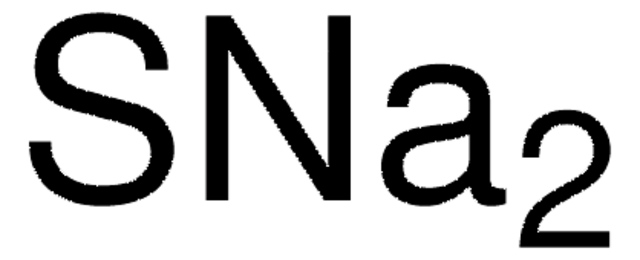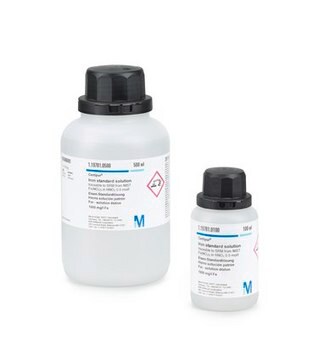203890
Nickel(II) sulfate heptahydrate
99.999% trace metals basis
Sinónimos:
Nickel sulfate heptahydrate, Nickelous sulfate heptahydrate
About This Item
Productos recomendados
grade
for analytical purposes
assay
99.999% trace metals basis
form
crystals and lumps
impurities
≤15.0 ppm Trace Metal Analysis
density
1.948 g/mL at 25 °C (lit.)
application(s)
battery manufacturing
SMILES string
[Ni++].[H]O[H].[H]O[H].[H]O[H].[H]O[H].[H]O[H].[H]O[H].[H]O[H].[O-]S([O-])(=O)=O
InChI
1S/Ni.H2O4S.7H2O/c;1-5(2,3)4;;;;;;;/h;(H2,1,2,3,4);7*1H2/q+2;;;;;;;;/p-2
InChI key
OGKAGKFVPCOHQW-UHFFFAOYSA-L
¿Está buscando productos similares? Visita Guía de comparación de productos
General description
Application
- As a vital precursor to generate nickel-rich cathode materials (NMC, NCA) for lithium-ion batteries using co-precipitation process because of its simplicity, ease of scale-up, and ability to produce a homogeneous structure at the particle scale.
- As a nickel source in the electrodeposition process to fabricate the Ni-NTNW (nickel nanotube network), which is then coated with the electroactive NiCo-LDH material to form the hierarchical supercapacitor electrode.
- As a precursor to synthesize the nickel(II) cinnamate complex, which is a key component in the preparation of the metal chelate monomers.
- To synthesize a highly efficient oxygen evolution reaction (OER) trimetallic Fe-Co-Ni electrocatalyst with other metal sulfates .
- To synthesize high entropy alloy for coatings to improve hardness, wear resistance and corrosion resistance.
Features and Benefits
- High purity with trace metal analysis (=< 15 ppm) for 32 elements, suitable for batteries.
- High water solubility ideal for synthesizing composites for various applications.
- Low ppm levels of metal ions including Al, K, Na, Mg, Cu, Co, etc.,7) 99.999% purity is ideal for nickel plating.
signalword
Danger
Hazard Classifications
Acute Tox. 4 Inhalation - Acute Tox. 4 Oral - Aquatic Acute 1 - Aquatic Chronic 1 - Carc. 1A Inhalation - Muta. 2 - Repr. 1B - Resp. Sens. 1 - Skin Irrit. 2 - Skin Sens. 1 - STOT RE 1 Inhalation
target_organs
respiratory tract irritation
Storage Class
6.1D - Non-combustible acute toxic Cat.3 / toxic hazardous materials or hazardous materials causing chronic effects
wgk_germany
WGK 3
flash_point_f
Not applicable
flash_point_c
Not applicable
ppe
dust mask type N95 (US), Eyeshields, Faceshields, Gloves, type P2 (EN 143) respirator cartridges
Elija entre una de las versiones más recientes:
¿Ya tiene este producto?
Encuentre la documentación para los productos que ha comprado recientemente en la Biblioteca de documentos.
Los clientes también vieron
Artículos
In many technologies, performance requirements drive device dimensions below the scale of electron mean free paths (λe). This trend has increased scientific interest and technological importance of electrical resistivities at the nanoscale.
Lithium-ion batteries represent a group of electrochemical devices used for electricity storage and have attracted a lot of attention in the past two decades due to their portability, rechargeability and low cost.
Plasmonic nanoparticles have unique optical properties that can be tailored to suit a variety of applications in the biotechnology1–8 and electronics9–16 industries.
Nuestro equipo de científicos tiene experiencia en todas las áreas de investigación: Ciencias de la vida, Ciencia de los materiales, Síntesis química, Cromatografía, Analítica y muchas otras.
Póngase en contacto con el Servicio técnico













